
views
Turning Your Pool off and Cleaning It
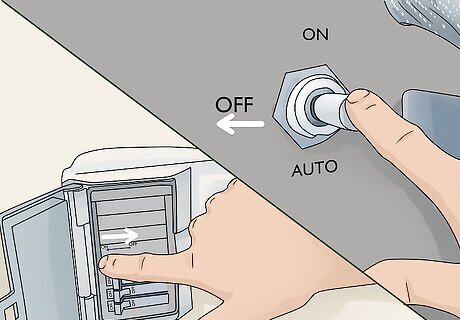
Turn the pump and electricity for your pool off. Flip the pump shutoff switch located on your pump. Depending on the brand of your pool, this switch could be on the pump itself, or on a nearby wall that is connected to your home. Turn the electricity for the pool off by flipping the breaker to your pool.
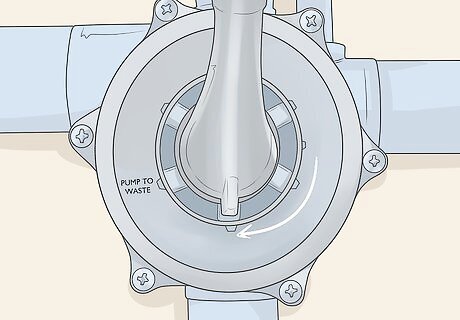
Set the filter setting to “vacuum,” “cleaning,” or “pump to waste.” Once your pump and electricity are off, go to your pool’s filter. Most filtration systems have a switch or dial on them with multiple settings based on whether you’re swimming, cleaning, vacuuming, or changing the water. Turn your switch or dial to the “vacuum,” “pump to waste,” or “cleaning” setting to prepare the filter for vacuuming. On some pools, the label will read “vacuum.” On others, it will say “clean,” or “pump to waste.” These terms are often used interchangeably, but can sometimes mean different things. Always consult the manual for your filter before turning the dial or switch.Tip: If your pool has a backwash setting, run it for 10-15 minutes before changing the filter setting to “vacuum” or “cleaning.” This will reverse the flow of water temporarily and allow all of the debris that has washed into your filter to be pushed back into the pool.
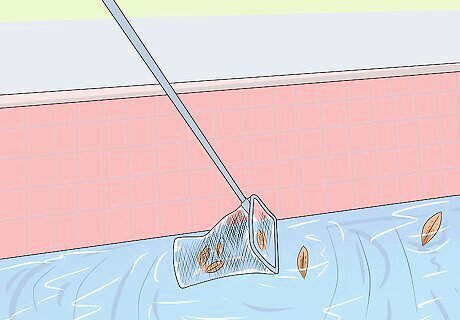
Scoop out leaves and larger debris from your pool. To make the vacuuming process easier, remove large debris, leaves, or foreign objects with a handheld net. Scrub off any debris stuck to the sides of your pool with a brush. Remove any visible debris and discard it before checking your skimmers.
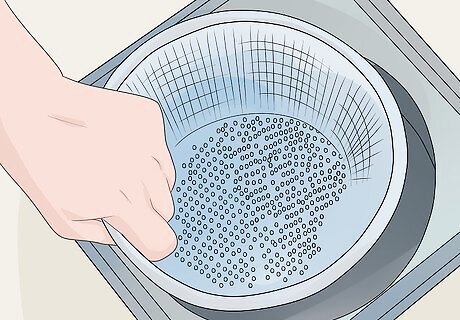
Empty your skimmer baskets and close all but one of the weirs. The skimmers are the small openings near the top of your pool that collect leaves and debris as they float on the surface of your water. Empty them out by prying each skimmer lid off and emptying the basket. If there are weirs, or gates, on your skimmers, slide or fold the gates closed. Leave the skimmer weir closest to your pump open. Most skimmers have weirs that automatically close when the pump shuts off so that debris doesn’t float back into the pool. If you don’t know where your skimmers are, look for small, circular covers 1–2 feet (0.30–0.61 m) from the edge of your pool. A pool may have anywhere from 1-6 skimmers depending on the size.
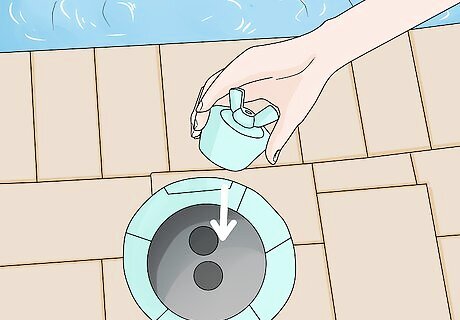
Plug the closed skimmers with rubber plugs if your pool has them. Some pools come with removable rubber plugs that cover the skimmer baskets. These are designed to stop all flow of water from the pool to your pump. If your pool came with plugs for the skimmer baskets, put them in every skimmer except the one closest to your pump. If your skimmers have weirs, your pool may not have come with rubber plugs. If your skimmers have weirs and your pool also came with plugs, close the weirs in addition to plugging the skimmers.
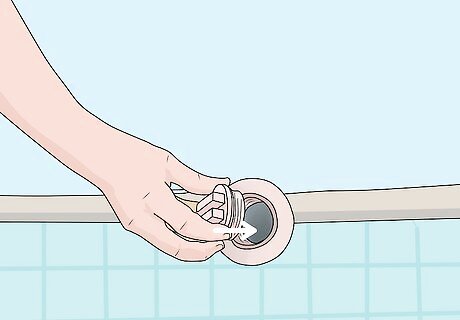
Find the return line jets and turn them towards the bottom of your pool. The return line fittings are the covers to your pool’s jets and send water into the pool. They are placed along the walls of a pool, usually halfway between the top and bottom of the pool. Find the fittings in your pool and point each one to the floor of your pool by twisting them with your hand. This will prevent stagnant water from flowing into the distribution pipes in your pool while you’re setting up or using your vacuum.
Assembling Your Vacuum and Hose
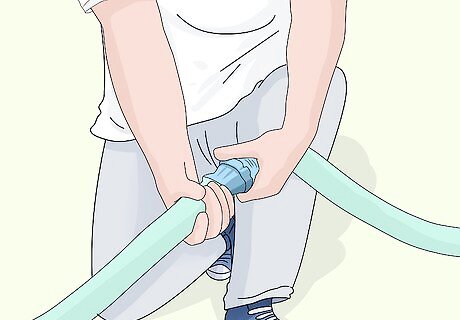
Assemble the vacuum hose by twisting the hose pieces together. The size of your vacuum hose is dependent upon the length of the pool. The hose must be long enough to reach every section of your pool’s floor from the location where you’re installing it. On most vacuum systems, all you need to do is screw the threading together for each section of hose until you’ve assembled the whole hose. Read your specific vacuum’s manual to find out where you need to install the end of your. Each brand and variety of vacuum is different, but most of them hook up to the filter, open skimmer, or suction port. Some hoses will need to be assembled in a specific order. Consult your specific vacuum’s instruction manual to see if there is a unique order that you need to attach the hose sections in.
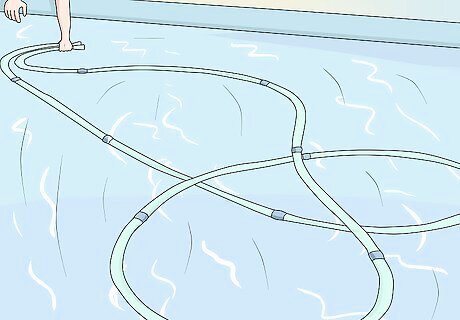
Submerge your hose in the pool to fill it up with water. You don’t want any air in your pump system, so you need to remove all of the air from the hose before using it. Place it in a deep section of the pool and push each section down until you see all of the air bubbles escape. To do this quickly, hold the opening of your hose near a jet on the side of the pool. The jet will force water through the hose.
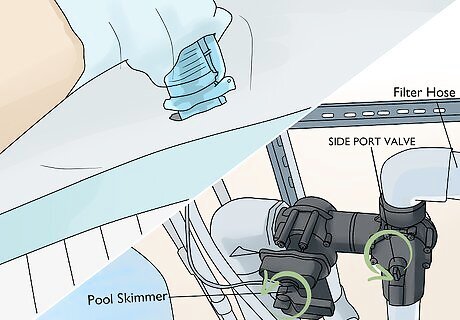
Attach the end of your hose to the skimmer, dedicated suction port, or filter. Every vacuum and pool is set up differently, so refer to your vacuum’s manual to determine where the hose needs to connect. The most common connection locations are the open skimmer, suction port, or filter. An automatic pool vacuum system uses the pool’s natural filtration system to clean it, so it could hook up to several ports since the entire pool uses the filtration system. Tip: If you’ve purchased a vacuum with a hose that doesn’t fit your skimmer, suction port, or filter, you will need to purchase an adapter. Some vacuum systems come with an adapter to fit it over a skimmer. To hook up your hose to the open skimmer, take the end of your hose and attach it to the adapter with the unthreaded side on the end. Stick the adapter inside the skimmer by fitting it into the opening under the lid. To hook up your hose to the suction port, inspect your filter for a handle on top of the valve where your filter pipe and water line meet. Twist the valve to open it and screw your hose into the threading. To fit your hose into the filter, inspect your sand filter and look for a cap that is labeled “return.” Unscrew this cap and screw your hose into it by using the threading on the hose or an adapter for the filter.
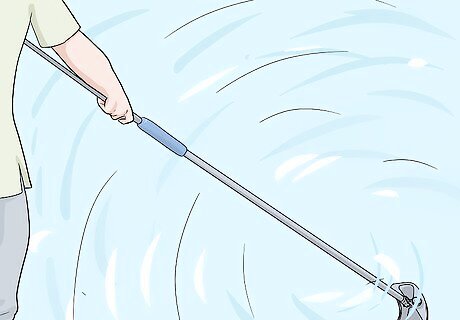
Place the vacuum underwater so that all air escapes. You can’t have any air pockets stuck in your vacuum. Remove them by holding the vacuum’s body underwater for 15-30 seconds and turning it around in the water. Once you notice that there are no bubbles popping up from your vacuum, you will know that there is no air remaining in the body of the vacuum.
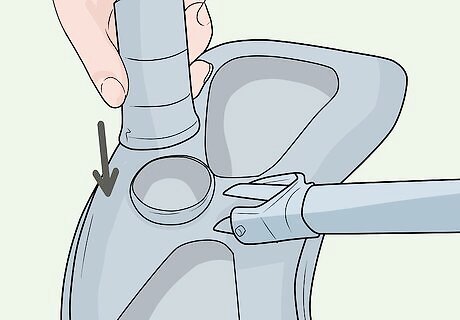
Connect the free end of the hose to the vacuum. Use the designated end of your hose to screw it into the top of your vacuum. Depending on the brand of your vacuum, there may be a label on a specific end of the hose indicating which end needs to be fed into the vacuum. Tighten the connection by hand by turning it until it won’t tighten any further. On a lot of hoses, there is a canister or float on the end of one length of hose. If your vacuum has a float or canister on one end of the vacuum hose, hook up the vacuum to the end nearest to the float or canister.
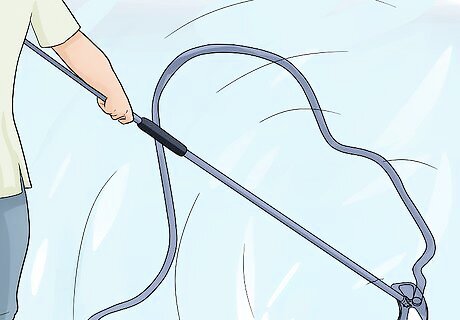
Lower your vacuum to the bottom of your pool. Use the hose to slowly lower your vacuum to the bottom of your pool. Let it down slowly so that the base of the vacuum sits flush against the floor of your pool. Readjust it if it falls over by pulling the hose to the opposite side to tilt it back up. Some pool vacuums automatically realign themselves when they reach the bottom of the pool.
Vacuuming Your Pool
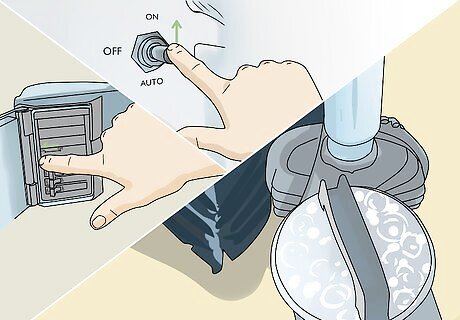
Turn your vacuum on by turning the pump back on. Turn the electricity and the pump for your pool back on by flipping the switches. The vacuum will automatically begin to scrub and clean the tiles of your pool. Most vacuums will take 30-60 minutes to fully vacuum an average-sized pool.Tip: Some vacuum systems come with a flow regulator valve. If your vacuum has one, check the reading to make sure that it matches the reading on your pool’s pump. If it doesn’t, increase or decrease your pump’s power output by turning it up or down on your pump’s control panel until it matches the vacuum.
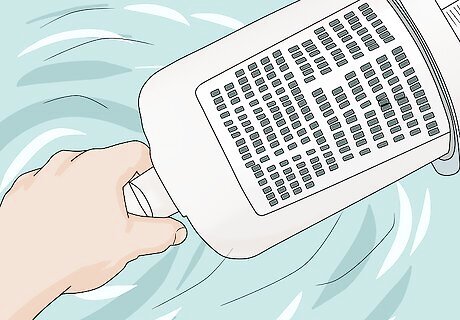
Keep an eye on the canister while the vacuum runs to make sure it remains unclogged. The canister is either on the vacuum itself, or a length of hose near your vacuum. These canisters are almost always translucent so that you can see if it fills up with dirt and debris while the vacuum is running. If it gets clogged, the vacuum will stop functioning properly or running altogether. Clean the canister out by turning the pump off and emptying it before you resume cleaning.
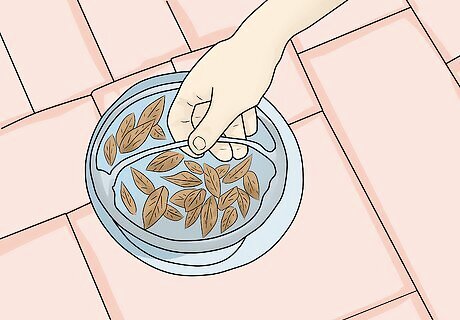
Monitor the remaining skimmer basket while you’re cleaning. If your vacuum empties through the open skimmer closest to your pump, keep an eye on the basket while the vacuum is running. If the skimmer basket gets too full for the water to continue running through it, empty it out as the vacuum is running. Keep a trash can or trash bag nearby so that you can quickly empty your skimmer basket if you have to. The pool would need to be very dirty for this to happen though.
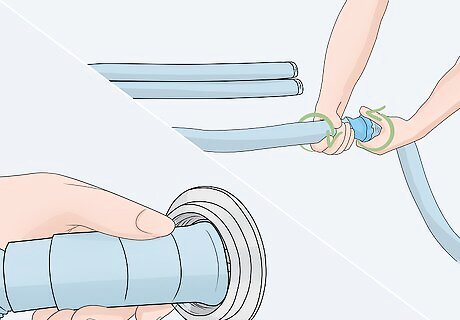
Disassemble the vacuum when the pool is clean. Work from the body of the vacuum to the bottom of the hose. Loosen the hose’s connection on the vacuum and set it aside. Remove each length of hose and dump out the water in a separate sink or grassy area in case there is any debris trapped in the hose. Disconnect the vacuum from the skimmer, dedicated suction port, or filter and replace any caps on those components. Empty the canister on the hose or vacuum and clean it out with mild dish soap and water. This will prevent it from getting moldy before your next vacuuming.

Reopen your skimmers and put the skimmer baskets back. Put each basket back into the corresponding skimmer and remove any rubber plugs. Open each weir and turn your jets to whatever direction that you want them to face.
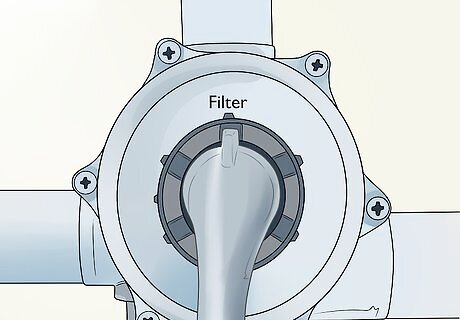
Turn your filter back to the “filter” or “circulate” setting. Once all of the skimmers are open, turn your filter back to the standard “filter” setting. Turn the filter to “circulate” if you want the water in your pool to slowly filter through a sand reservoir if you aren’t going to be using your pool for a while. This will keep the water chlorinated and moving without using too much energy. On some filters, the standard filter setting is labeled “normal” or “standard.”




















Comments
0 comment